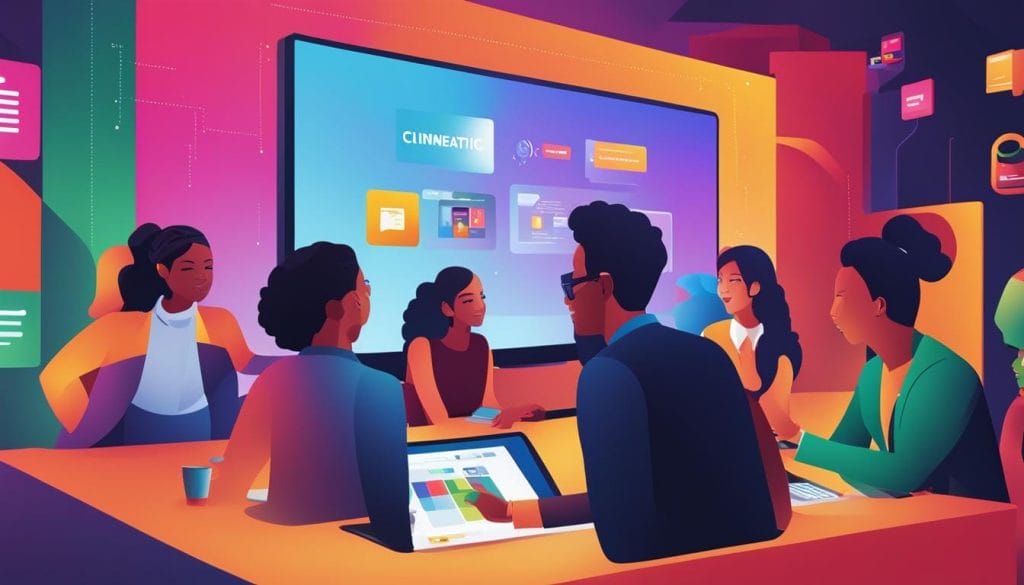Have you ever wondered how education can be transformed through social interactions and collaboration in the digital age? Is it possible for online learning to provide interactive and community-based learning experiences? What if I told you that social learning holds the key to revolutionizing education in the modern world?
In today’s digital landscape, online learning platforms have opened up new possibilities for collaborative and interactive learning experiences. Social learning, also known as collaborative or interactive learning, takes advantage of these platforms to enhance learning outcomes through shared knowledge and collective support.
Whether you are a student seeking a more engaging learning experience or an organization looking to foster a culture of continuous learning, understanding the power of social learning in the digital age is essential.
In this article, we will explore the transformative potential of social learning and how it can revolutionize education in the digital age. From the impact of technology on interpersonal exchanges to the benefits of social learning in the workplace, we will uncover the key insights and strategies to leverage the power of social learning for personal and professional growth.
Key Takeaways:
- Social learning leverages social interactions and collaboration to enhance learning outcomes.
- Online learning platforms provide opportunities for interactive and community-based learning experiences.
- Technoference, the interference of technology in interpersonal exchanges, can impact attachment and social-emotional functioning.
- Technology use has both positive and negative impacts on social learning.
- Transitioning to digital learning models offers benefits such as flexibility and cost savings.
The Impact of Technoference on Attachment and Social-Emotional Functioning
Technoference, a term used to describe the interference of technology in interpersonal exchanges, can have a significant impact on attachment and social-emotional functioning. Research suggests that frequent technoference can disrupt the attachment between mothers and their elementary-aged children, leading to potential consequences in social and emotional development.
One study conducted by McDaniel and Radesky (2018) examined the effects of technoference on mother-child interactions and found that increased interruptions and distractions from technology were associated with decreased overall positive involvement and emotional availability from the mother. This disruption in the attachment bond can have long-term implications for the child’s social and emotional development.
In addition to its impact on attachment, technoference can also affect social-emotional functioning. A study by Lapierre, Hohmann-Marriott, and Stepp (2019) explored the relationship between technoference and social-emotional functioning in both mothers and children. The results showed that higher levels of technoference were associated with lower ratings of social-emotional functioning by both mothers and children. This suggests that technoference can hinder individuals’ ability to effectively navigate social interactions and regulate emotions.
However, it is important to note that the impact of technoference on attachment and social-emotional functioning may be moderated by the quality of the mother-child attachment relationship. A secure and responsive attachment between the mother and child may buffer the negative effects of technoference to some extent, mitigating its impact on social-emotional functioning.
The disruption caused by technoference in interpersonal exchanges can impede the development of secure attachment bonds and hinder social-emotional functioning in both mothers and children. However, the quality of the mother-child attachment relationship may play a mitigating role in the face of technoference.
To gain a better understanding of the impact of technoference on attachment and social-emotional functioning, further research is needed to explore the specific mechanisms through which technoference influences these areas. By identifying these mechanisms, interventions and strategies can be developed to minimize the negative effects of technoference and enhance social-emotional well-being in the digital age.
Impact of Technoference on Attachment and Social-Emotional Functioning
| Effects of Technoference | Findings |
|---|---|
| Disruption of attachment between mothers and children | Increased interruptions and distractions from technology lead to decreased positive involvement and emotional availability of mothers |
| Lower social-emotional functioning | Higher levels of technoference are associated with lower ratings of social-emotional functioning by both mothers and children |
| Moderating role of mother-child attachment | The quality of the mother-child attachment relationship may buffer the negative effects of technoference on attachment and social-emotional functioning |
Understanding the impact of technoference on attachment and social-emotional functioning is crucial in navigating the digital landscape and promoting healthy interactions in the digital age.
The Positive and Negative Impacts of Technology Use

Technology use in the digital age can have both positive and negative impacts on individuals and society. Understanding these implications is crucial when considering technology’s role in social learning.
Positive Impacts:
Technology has enabled immediate support for individuals facing eating disorders or depression. Online platforms provide access to support communities, resources, and professional guidance. Individuals can seek help, share experiences, and find solace in a safe and inclusive digital environment.
Mothers, in particular, benefit from technology use. Online spaces offer a platform for seeking support, connecting with other parents, and sharing parenting advice. These communities provide valuable emotional and informational support, especially during challenging times.
Technology has opened up new avenues for individuals with eating disorders to connect with others facing similar challenges and access resources for recovery.
Negative Impacts:
However, technology use can also give rise to challenges and negative effects. One such challenge is technoference, which refers to the interference of technology in face-to-face interactions. Continuous distractions and excessive screen time can disrupt personal relationships, hinder communication, and negatively impact social-emotional functioning.
Moreover, excessive reliance on technology can lead to social isolation, reduced physical activity, and decreased face-to-face interactions. These factors can contribute to feelings of loneliness, depression, and a decline in overall well-being.
The Role of Technology in Social Learning
As technology continues to shape the digital landscape, it is important to consider both the positive and negative impacts it may have on social learning. By leveraging its benefits and addressing its challenges, educators and learners can harness the power of technology to enhance collaboration, foster community, and drive educational outcomes.
| Positive Impacts | Negative Impacts |
|---|---|
| Immediate support for individuals with eating disorders or depression | Challenges such as technoference and negative effects on social-emotional functioning |
| Opportunities for mothers to seek support and connection online | Social isolation, reduced physical activity, and decreased face-to-face interactions |
By proactively addressing the negative impacts and fostering responsible technology use, social learning can be enhanced in the digital age. It is important to strike a balance between utilizing technology as a tool for collaboration and connection while also promoting in-person interactions and maintaining a healthy relationship with technology.
Transition to Digital Learning Models
Before the COVID-19 pandemic, many businesses relied on traditional in-person training models. However, these models had limitations, such as a lack of post-session follow-up and difficulties in coordinating schedules. The shift to digital learning models offers numerous benefits, including flexibility in learning schedules and cost savings. Online platforms provide a more productive work environment by facilitating social and collaborative learning.
The transition to digital learning models has revolutionized the way organizations approach training and development. In-person training often required participants to dedicate a specific time slot, making it challenging for individuals with busy schedules or remote employees. With digital learning models, employees have the flexibility to access training materials at any time and from any location. This adaptability not only increases engagement but also ensures that valuable learning opportunities are not missed.
The Advantages of Digital Learning Models
One of the key advantages of digital learning models is the ability to provide post-session follow-up. In traditional in-person training, once the session ended, there was little follow-up or reinforcement of the concepts covered. This lack of reinforcement could lead to a loss of knowledge retention over time. However, digital learning models allow for post-session follow-up through various means, such as online quizzes, discussion forums, or personalized feedback. These follow-up activities ensure that learners have a deeper understanding of the material and can apply it effectively in their work.
Another advantage of digital learning models is their cost-effectiveness. In-person training often involves expenses such as travel, accommodation, and venue rental. Digital learning eliminates these additional costs, making professional development more accessible and affordable for organizations of all sizes. By investing in digital learning platforms, businesses can allocate their resources more efficiently and reach a larger number of employees, regardless of geographical location.
Furthermore, digital learning models provide opportunities for social and collaborative learning. Online platforms foster interaction and engagement among learners, allowing them to share experiences, ask questions, and collaborate on projects. This collaborative learning environment enhances knowledge sharing and encourages employees to connect and learn from one another, even when geographically dispersed.
Overall, the transition to digital learning models has revolutionized the way organizations approach training and development. By embracing the advantages of digital learning, businesses can overcome the limitations of in-person training and create a more flexible, engaging, and cost-effective learning experience for their employees.
The Benefits of Social Learning in the Workplace

Social learning in the workplace has numerous advantages that contribute to a more engaged workforce and a thriving work environment. By harnessing the support and expertise of peers and subject-matter experts, employees can tap into a wealth of knowledge and experience, fostering personal growth and professional development.
One of the key benefits of social learning is the opportunity for employees to receive support from their peers. When individuals have access to a supportive network, they feel empowered to take on new challenges and explore innovative ideas. The encouragement and guidance provided by colleagues create a positive feedback loop that drives continuous improvement and higher performance.
In addition to peer support, social learning promotes communication within the organization. By creating a social environment where employees can interact, share knowledge, and ask questions, companies foster open lines of communication that facilitate collaboration and teamwork. This increased communication leads to a stronger sense of belonging and shared purpose among team members.
Furthermore, social learning embraces the power of collaboration and collective intelligence. Through collaborative projects and discussions, employees are encouraged to contribute their unique perspectives and skills, resulting in creative problem-solving and innovative solutions. This collaborative approach also cultivates a culture of learning, where employees feel safe to experiment, share ideas, and learn from each other’s successes and failures.
By leveraging learning management systems (LMS) and collaboration platforms, organizations can create a cohesive and efficient social learning ecosystem. These tools provide a centralized hub for knowledge sharing, training resources, and interactive discussions, enabling employees to engage in continuous learning and development. The seamless integration of technology and social learning empowers employees to access information and expertise at their fingertips, whenever they need it.
The image above visually represents the positive impact of social learning on creating an engaged workforce, where employees thrive and collaborate in a supportive social environment.
In summary, social learning in the workplace fosters an engaged workforce by tapping into the support and expertise of peers. It promotes communication, creates a social environment where employees can interact and share knowledge, and cultivates a culture of collaboration and continuous learning. By embracing social learning and leveraging the power of technology, organizations can improve employee engagement, foster innovation, and drive success.
Investing in the Learning Experience
An effective learning management system (LMS) is crucial for organizations looking to prioritize personalized skills development and create a unique learning experience for their employees. By investing in the learning experience, companies can cultivate a high-performing workforce and improve customer loyalty.
A well-designed LMS allows companies to tailor training programs to meet the specific needs of individual employees, ensuring that they acquire the skills necessary to excel in their roles. This personalized approach to skills development not only enhances employee productivity but also fosters a sense of value and fulfillment.
Furthermore, a robust learning management system facilitates collaboration among employees, providing them with a platform to brainstorm ideas, share knowledge, and align on objectives. By fostering a culture of collaboration, companies can tap into the collective intelligence of their workforce and drive innovation.
Implementing a learning management system offers several benefits, including:
- Flexibility in accessing training materials and resources
- Engaging and interactive learning experiences
- Tracking and measuring employee progress and performance
- Cost-effective training solutions
By leveraging a comprehensive LMS, organizations can empower their employees to continuously develop their skills, knowledge, and competencies, leading to a high-performing workforce that drives business growth and success.
Take a look at the table below for a comparison of different learning management systems:
| LMS | Key Features | Price |
|---|---|---|
| Company A LMS | Interactive courses, customizable learning paths, analytics | $XX/month |
| Company B LMS | Social learning, gamification, mobile-friendly | $XX/month |
| Company C LMS | Advanced reporting, certification management, integrations | $XX/month |
The table above provides an overview of different learning management systems available in the market. Organizations should carefully evaluate their requirements and choose an LMS that best aligns with their goals and objectives.
Creating a Unified Company Culture

Consolidation tools and platforms that combine communication, training, and information delivery play a vital role in creating a unified company culture. By providing a simple and accessible platform for company-wide communications and collaboration, organizations can improve the employee experience, facilitate knowledge sharing, and save time and resources.
With company-wide communications platforms, organizations can ensure that important messages reach every employee in a timely manner. Whether it’s company announcements, policy updates, or project progress reports, a centralized platform becomes the one-stop-shop for all internal communication needs.
These platforms not only streamline communication but also foster a sense of unity and belonging among employees. By creating an inclusive and transparent environment, organizations can build a unified company culture that promotes collaboration and teamwork.
Benefits of Consolidation Tools:
- Efficient and effective communication across all levels and departments of the organization.
- Enhanced collaboration and knowledge sharing, leading to innovative ideas and solutions.
- Improved employee engagement and satisfaction due to increased transparency and involvement.
- Saved time and resources by eliminating the need for multiple communication channels and systems.
Consolidation tools act as a cornerstone for nurturing a unified company culture. By providing a seamless platform for communication and collaboration, organizations can break down silos and create an environment where everyone feels connected and engaged.
Furthermore, consolidation tools can support various learning initiatives within the organization. From training programs to onboarding processes, having a centralized platform ensures that employees have easy access to all the necessary information and resources. This accessibility fosters a culture of continuous learning and development.
Example of a Consolidation Tool:
| Features | Benefits |
|---|---|
| All-in-one communication | Saves time by eliminating the need for multiple communication tools. |
| Document sharing and collaboration | Facilitates teamwork and knowledge sharing. |
| Training and onboarding modules | Streamlines learning initiatives and ensures easy access to resources. |
| Analytics and reporting | Provides insights on employee engagement and communication effectiveness. |
By implementing consolidation tools and platforms, companies can create a unified company culture where communication flows seamlessly, collaboration thrives, and employees feel connected to the organization’s mission and values. This not only leads to improved productivity and efficiency but also enhances employee satisfaction and retention.
The Future of Social Learning in the Digital Age
In the rapidly evolving digital landscape, the future of social learning holds immense potential. As learning technologies continue to advance, online platforms, interactive learning tools, and collaboration features are set to transform the social learning experience.
The emergence of online platforms has opened up new avenues for interactive and community-based learning. Learners can connect with peers, share knowledge, and engage in collaborative activities, fostering a dynamic learning environment. With the integration of learning technologies, social learning can become even more immersive, engaging, and impactful.
Learning technologies such as virtual reality (VR) and augmented reality (AR) are poised to revolutionize the way we learn and interact with information. These technologies offer a unique opportunity to create immersive learning experiences, allowing learners to explore realistic scenarios and gain practical skills in a simulated environment.
Collaboration features, such as discussion boards, group projects, and live video conferencing, facilitate peer-to-peer learning and create a sense of community. Learners can exchange ideas, seek feedback, and benefit from diverse perspectives. This collaborative approach encourages active participation, critical thinking, and problem-solving skills.
Embracing the Power of Social Learning Technologies
Organizations and educational institutions must adapt to leverage the power of social learning technologies. Integrating these technologies into existing learning frameworks can enhance the learning experience and drive better learning outcomes.
- Utilize virtual reality (VR) and augmented reality (AR) to provide hands-on training experiences and bridge the gap between theory and practice.
- Incorporate gamification elements to increase learner engagement and motivation.
- Implement personalized learning pathways to cater to individual learners’ needs and interests.
- Leverage analytics and data-driven insights to track learner progress and tailor learning experiences accordingly.
By investing in learning technologies and embracing social learning, organizations can create a future-ready workforce that thrives in the digital age. The ability to adapt, collaborate, and continuously learn has become crucial in an ever-changing job market.
The Key Benefits of Social Learning Technologies
When harnessed effectively, social learning technologies offer numerous benefits:
- Enhanced engagement: Social learning technologies foster active participation, collaboration, and peer interaction, keeping learners engaged and motivated.
- Improved knowledge retention: By applying social learning principles, learners can reinforce their understanding through active discussions and knowledge sharing.
- Increased accessibility: Online platforms and mobile learning technologies make learning accessible anytime, anywhere, catering to the diverse needs of learners.
- Expanded learning opportunities: Social learning technologies connect learners to a vast pool of expertise, enabling them to tap into the collective knowledge of a global community.
“Social learning technologies have the potential to transform education and training, creating a dynamic, collaborative, and personalized learning experience.”
The future of social learning in the digital age holds immense promise. By embracing learning technologies and fostering a collaborative learning environment, organizations and educational institutions can harness the power of social learning to drive innovation, creativity, and lifelong learning.
Conclusion
Social learning in the digital age holds immense potential for transforming education and fostering collaborative and interactive learning experiences. By leveraging online platforms and collaboration tools, individuals and organizations can tap into the collective knowledge and support of a community, enhancing learning outcomes and engagement.
The power of social learning lies in its ability to create a social environment where learners can interact, share knowledge, and ask questions. This collaborative approach to learning fosters a sense of community and allows for personalized skills development. Online platforms and learning management systems (LMS) play a crucial role in facilitating social learning and creating a unique learning experience.
Embracing social learning in the digital age is key to unlocking the full potential of education and personal growth. As the digital landscape continues to evolve, it is essential for educational institutions and organizations to adapt and leverage learning technologies. By embracing social learning, we can revolutionize education and prepare individuals for success in the ever-changing digital landscape.





